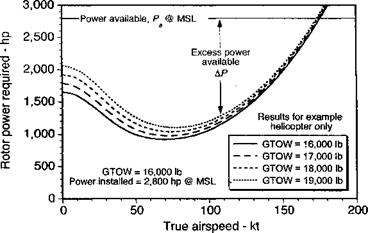Performance Analysis
5.5.1 Effect of Gross Weight
Clearly the power required in forward flight will be a function of helicopter weight. Because a relatively small weight fraction of fuel is carried relative to total weight, it is convenient to represent the performance results in terms of gross take of weight (GTOW). Representative results showing the effect of GTOW on the rotor power required are given in Fig. 5.11 for the example helicopter at mean sea level (MSL) conditions. Note that with increasing GTOW, the excess power available becomes progressively less, but it is particularly affected at lower airspeed where the induced power requirement constitutes a greater fraction of the total power. In this case, the power available at MSL is 2,800 hp and for a turboshaft engine this stays relatively constant with airspeed. The airspeed obtained at intersection of the power required curve with the power available curve gives the maximum level flight speed; however, the maximum speed may be limited by the onset of power creep from compressibility effects or high blade loads associated with rotor stall before this point is reached.
|
Figure 5.11 Predictions of main rotor power in forward flight at different gross takeoff weights. |














